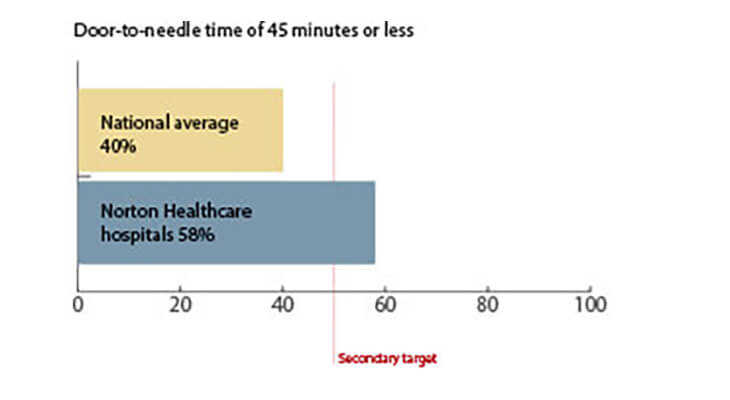Int J Stroke 20149 suppl 46 Comparison of in- v out-of-hours. Therefore registering the in-hospital time to treatment with IVT ie.
Technology And Collaboration Drive Dramatic Improvements In Stroke Treatment Ems World
The goals for Target.

Door to needle time stroke. Time to Intravenous Thrombolytic Therapy 45 min. This association was not observed for patients treated beyond 90. Percentage of acute ischemic stroke patients given intravenous IV alteplase door-to-needle time within 60 min and door-to-needle time within 45 min among IV alteplase given within 45 h of symptom onset by year.
Foster LDE Devine J Dzvene M Bathula R Cohen DL. The goal set for Target. Percent of acute ischemic stroke patients receiving intravenous tissue plasminogen activator tPA therapy during the hospital stay who have a time from hospital arrival to initiation of thrombolytic therapy administration door-to-needle time of 45 minutes or lessTARGET.
The mRS score ofless than or equal to2 improved from 471 to 733 at 90 days P001. Achieve door-to-needle times within 60 minutes in 75 percent or more of acute ischemic stroke patients. Intravenous thrombolysis IVT plays a prominent role in the treatment of acute ischemic stroke AIS.
Achieve door-to-needle times within 45 minutes in 50 percent or more of acute ischemic stroke patients. With stroke patients saving minutes can mean a patient walks out of the hospital ready to resume an active life. More patients who were treated at teaching hospitals but not at primary stroke centers were treated within shorter door-to-needle times.
Stroke is to achieve a door to needle DTN time within 60 minutes in at least 50 of ischemic stroke patients treated with IV rt-PA CURRENT AHAASA GUIDELINE RECOMMENDATIONS Intravenous rt-PA for acute ischemic stroke represents one of the few therapies demonstrated to improve clinical outcomes. For a hospital to be a designated stroke center that time has to be less than 60 minutes we call that the door-to-needle time. Other metrics such as staff engagement with the stroke service and.
The median door to needle dropped from 655 minutes in 2012 to 49 minutes in 2014. Stroke a multidimentional initiative elevates clinical performance in the care of acute ischemic stroke patient facilitate a rapid integration of evidence into clinical practice and improve outcomes. The times continued to be much shorter within hours when the stroke team was on site.
Stroke Phase II are. Complications were reduced from 157 to 88 P14. This was comprised of a general reduction in the time taken to traverse the pathway.
Conclusions There is now a broad understanding of the causes of delays to fast treatment and the strategies that can be employed to improve door-to-needle time such that most centers could achieve median door-to-needle time of 30 min. The implementation of telestroke programs has allowed patients living in rural areas suffering from acute ischemic stroke to receive expert acute stroke consultation and intravenous Alteplase tPA. The purpose of this study is to compare door to needle DTN time when tPA is administered at telestroke sites spokes through telestroke.
On the surface 60 minutes seems like a long time and many people would wonder why it would ever take that long to given an IV medication after a patient comes to the ER. Improving Door-to-Needle Time for Stroke Patients. 201382 Comparison of consultant DTN times Do thrombolysis door-to-needle times vary according to the speciality of the thrombolysing consultant.
Every 15-minute increase in door-to-needle time was associated with higher 1-year all-cause mortality aHR 104. The sooner IVT is administered the higher the odds of a good outcome. The goal is to administer tissue plasminogen activator tPA a serine protease that catalyzes the conversion of plasminogen to plasmin to the right patients as quickly as possible.
95 CI 102-105 for door-to-needle time within 90 minutes of arrival. If playback doesnt begin shortly try. DTN improved from 8326477 to 4709257 minutes P.
The median door-to-needle time was 65 minutes with 56 of patients treated with tPA within 30 minutes of hospital arrival 208 within 45 minutes and 441 within 60 minutes. Studies have found that less than 30 of US pts are treated within door to needle time of 60 minutes or less. Sivagnanaratnam A Devine J Craig T Foster L Bathula R Cohen D.
One year later ischemic stroke patients treated with intravenous tissue plasminogen activator tPA who had door-to-needle times longer than 45 minutes had higher all-cause mortality 350 vs. The door-to-needle time DNT is a powerful way to measure quality improvement. Mean door-to-CT time improved from 425411 to 271263 minutes P.
The aim of this study was to identify.